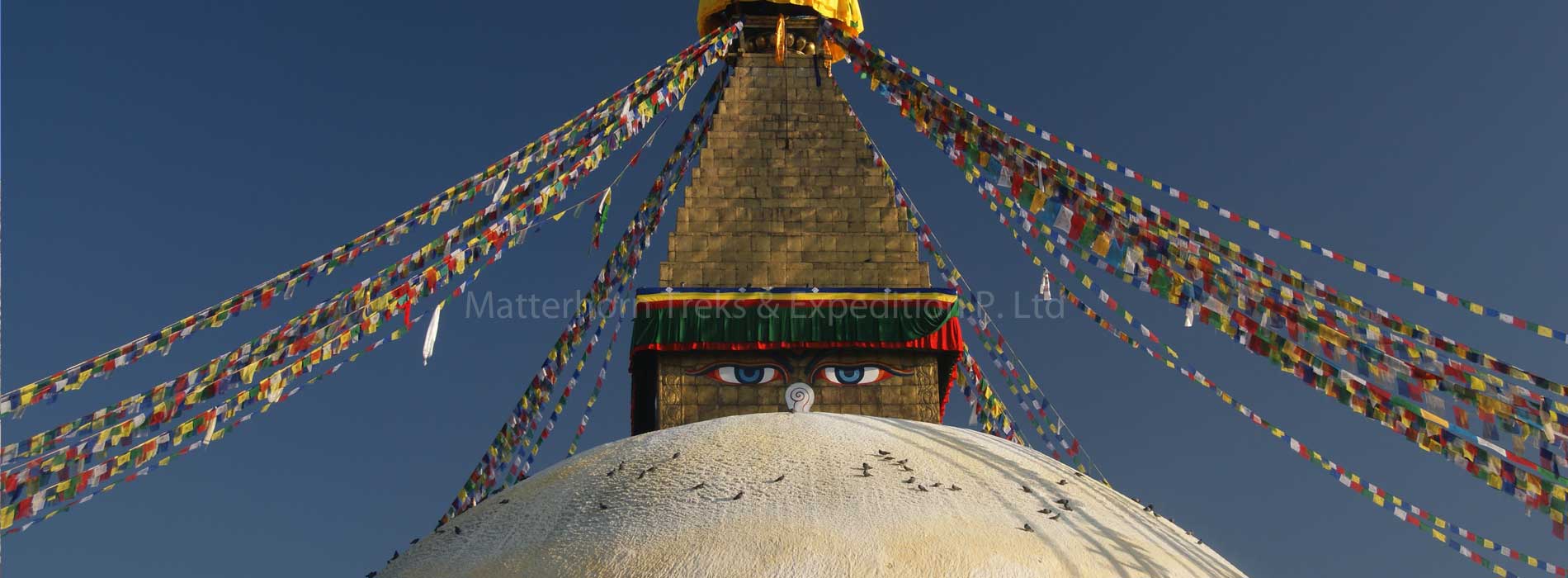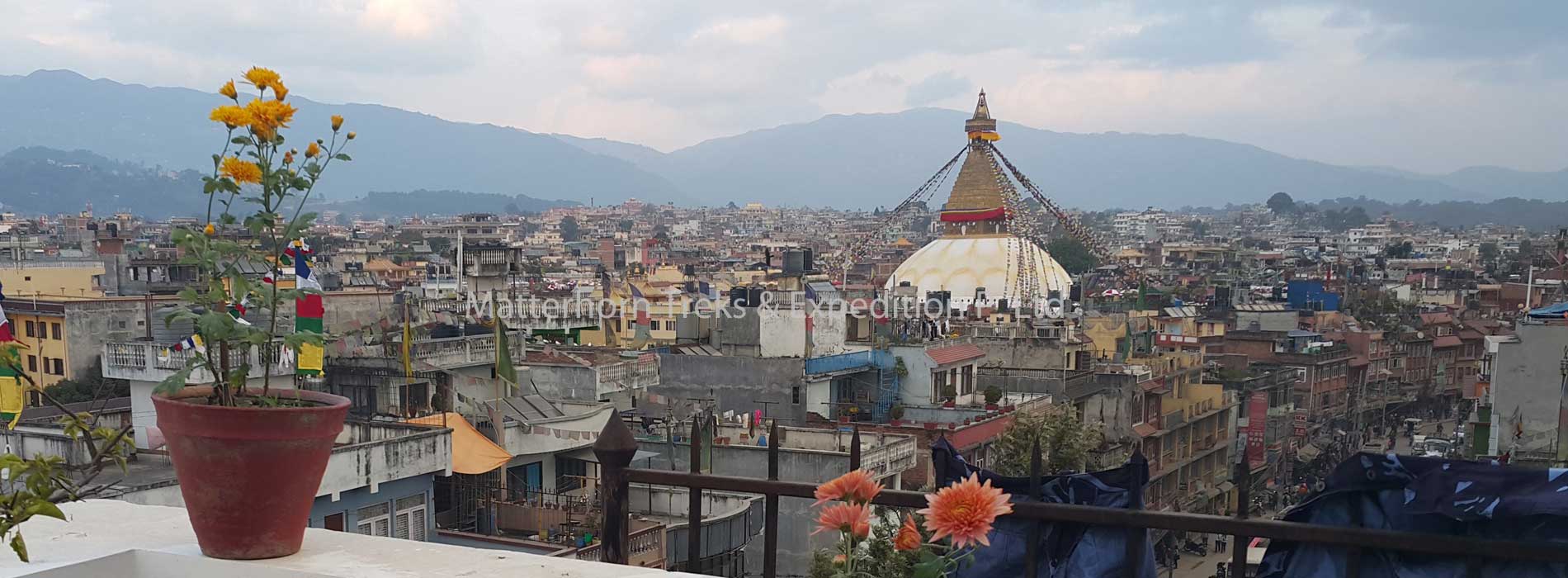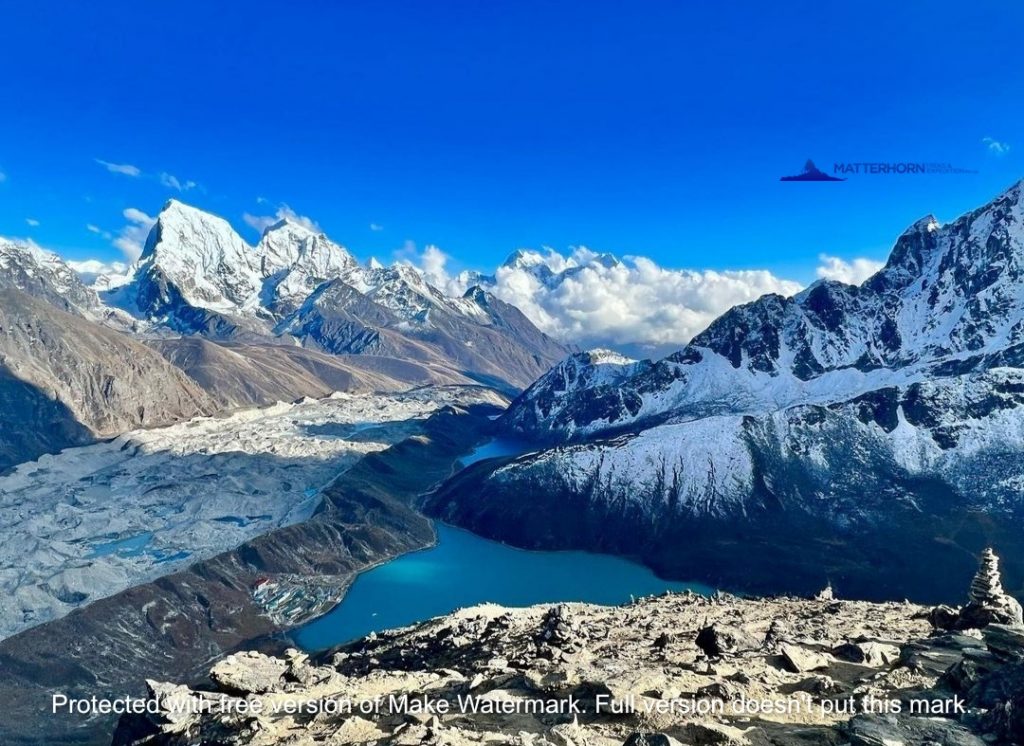


Nepal a tiny Himalayan Kingdom situated between two large countries China and India, is the birthplace of Lord Buddha & The light of Asia” & land of famed Gorkha warriors. Nepal is also known as the land of Himalayas as it consists eight of the highest ten mountains over 8000 meters, including the highest mountain Mt. Everest, the top of the world.
The Kingdom of Nepal is well known as one of the best destinations in the world for enjoying the real combination of nature and the culture. The centuries old cities, panoramic views of the Himalayas, green forest with different types of wild animals and more than 800 species of birds and above all warm greeting from smiling and friendly people makes Nepal popular destination.
The capital city Kathmandu is famous for its cultural heritage which is surrounded by the beautiful landscapes and the views of the mighty Himalayas. Within 30 Km of surrounding, there are seven heritage sites including old cities, temples and Monasteries under the preservation of UNESCO.
The Valley is situated at an altitude of 1,336 m above sea level and covers an area 218 sq. miles The rich tapestry of the cultural heritage of Nepal is synthesized in the Kathmandu Valley, the home of the ancient and sophisticated Newari Culture. The newars are the indigenous inhabitants of the Valley and the creators of the splendid civilization of its three cities – Kathmandu, patan and Bhaktapur. The skillfully – built temples and palaces, delicately – engraved stone and metal images, carved wooden columns and pillars, and the history laden shrines and chaitya of these three historical cities stand testimony to the newar&ampamprsquos artistic achievements.
Temples of Kathmandu
Boudhanath
The stupa of Boudhanath lies approximately 8 km North East from center of the Kathmandu Valley. This ancient colossal Stupa is one of the biggest in the world. It was listed in the UNESCO world Heritage Monument List in 1979.
Nepal is one of the richest country in the world in terms of bio-diversity due to its unique geographical position and altitudinal variation. There are four UNESCO World Heritage Sites in Nepal i.e Lumbini (birth place of Lord Buddha), seven monuments of Kathmandu Valley within a radius of 20 km (together counted as one Heritage Site), Chitwan and Sagarmatha National Parks. Kathmandu Valley World Heritage Site comprises of three historical palaces – Kathmandu, Patan and Bhaktapur Durbar Squares; two Hindu temples – Pashupatinath and Changu Narayan; and two Buddhist stupas – Swayambhunath and Boudhanath.
The Great stupa of Boudhanath stands approximately 8 km North East from center of the Kathmandu Valley. Surrounded by hills, Boudhanath stupa is a jewel point in the centre of a natural mandala, a store of scared energy. It is one of the most important place of pilgrimage for the Buddhist. It is the principal center of Himalayan Buddhist worship and studies in the Kathmandu Valley. It is also one of the largest and most significant Buddhist monument in the world.
The stupa is commonly known as Boudha or Boudhanath, meaning lord of wisdom. It is a protective, purifactory and wish – granting stupa. But further, because of its antiquity – it’s origins are beyond the recall of folk memory, it’s foundation and fabric impregnated with the vibration of innumerable generations of devoted worship and powerful meditation.
The splendid dome of Boudhanath stupa is approximately 120 ft in diameter, 1 hec in width and 43 m in height. Its simplicity of form is its principle feature, unique among monumental stupas in the valley in its lack of the appended five shrines of the Buddha. Some consider it represents the Adibuddha, the first or Primordial Buddha, free of conceptual side, seemingly the ladder that Sakyamuni ascended into Tushita heaven, breaks its uniformity.
Boudhanath stupa is a symbol of Nepal, a tribute to its rich spirituality and culture symbolizing a remnant of the past and a stepping-stone towards a better future. One that emphasizes the importance of conservation and development, yet at the same time maintains its purpose as a scared site of spiritually and unity for the many different groups of people. It is a reason that contributes to the many important factors in ensuring this special location remains a listed world heritage site.
Amongst the people who worship the stupa, the Tamang community forms the nuclear part. However, Tibetan refugees now form the numerically dominant and most active community of devotees. The Newars and the Sherpas are also a part of the many ethnic groups that keep this ancient site of worship alive and sacred today as it was centuries ago.
Machhendranath Temple
The temple of Sweta machhendranath is situated at machchendra Bahal between Indra Chowk and Asan, It is a pogada of considerable artistic beauty. The deity is also called Janmadyo or Machhendra.
Akash Bhairav Temple
A three – story temple in the main market avenue, called Indra Chowk, the image of Akash Bhairav is displayed outside for a week during Indra Jatra, the festival of Indra, the God of Rain.
Hanumandhoka (Kathmandu Durbar Square)
It is the historic seat of royalty. The Durbar Square, with its old temples and palaces, epitomizes the religious and cultural life of people. It is here that kings of Nepal are crowned and their coronations solemnized. Interesting things to see here are, Taleju temple built by king Mahendra Malla in 1954 AD, the temple of Kal Bhairab , the god of destruction, Nautale durbar, the statue of King Pratap Malla, the big drum and the Jaganath temple. It was listed in the UNESCO world heritage monument list in 1979.
On the right hand corner, a large wooden lattice screen hides an enormous gilded face of Sweta Bhairab. The screen is removed only during the Indra Jatra festival.. there are also the Numismatic museum and Tribhuban museum inside the Hanuman Dhoka palace building . Photography is prohibited inside the museums. Both the museums remain closed on Tuesday and government holidays.
Temple of living Goddess ( Kumari Ghar)
Kumari (Vestal virgin) , or living goddess, who represents a very ancient Hindu deity of Nepal locally known as Taleju, is Buddhist by birth. The Temple of Kumari is situated in the vicinity of Hanuman Dhoka Palace. The Bulding has intricately carved wooden balconies and window screens, the kumari acknowledges greetings from balcony (window). Once a year, During Indra jatra festival, the king of Nepal seeks the Kumari’s blessing.
Kasthamandup
Located near the temple of Kumari, it is said to have been build by King Laxmi Narsingha Mall in he beginning of the sixteenth century. It is said to be constructed from the wood of a single tree. The city of Kathmandu derives its name form this Temple.
Ashok Vinayak
The small but very important temple of Ashok Vinayak is situated behind the Kasthamandup. It is also known as Kathmandu Ganesh or maru Ganesh
Jaishi Dewal
A five-minute walk from Kasthmandap is the shiva Temple of jaishi dewal which is famous for its erotic carvings. It is still one of the main routs of the chariot festival of Indra Jatra and other festivals.
Bhandrakali Temple
At the eastern edge of the Tundhikhel, near Shahid Gate, stands the temple of goddess Bhadrakali. This temple is also known as Lumarhi temple and is one of the main Shakti Temples of Kathmandu city.
About 8 km north of Kathmandu at the base of Shivapuri hill is a remarkable huge statue of Lord Visnhu. Reclining on a bed of snakes.This is one of the masterpieces of stone sculptures of the Lichchhavi period. This fifth century statue is in the middle of a small pond and seems to float in water.
Swayambhuanth
This is one of the world’s most glorious Buddhist Chaityas. It is said to be 2,000 years old. Painted on the four sides of the spire &ampamprsquos base are the all seeing eyes of Lord Budhha. It is 3 Km west of Kathmandu city and it situated on a hillock about 77 m commands an excellent view of the Valley. This stupa is the oldest of its kind in Nepal. It was listed in the UNESCO world Heritage Monument List in 1979.
Pashupatinath Temple
Situated 5 km east of kathamandu, the temple of Lord Shiva, Pashupatinath, with two tired golden roof and silver door is considered one of the holiest for Hindus. Although only Hindus are allowed inside the temple, visitors can clearly see the temple and the activites performed in the Temple premises from the eastern bank of the Bagmati river. The Temple was listed in the UNESCO world heritage Monument List in 1979.
Guheswari Temple
Near Pahupatinath Temple is another historic and holy temple of Guheswari. Only hindus are allowed to enter the temple courtyard.
Chandra Vinayak
The temple of Chandra Vinayak is situated about 200 m north of Chabahil stupa. This double tiered brass- roofed temple house is with a tiny image of Lord Ganesh, the elephant head god.
Shekha Narayan
Situated between Chobhar and Dakshinkali the temple of Sheka Narayan represensts one of the famous lord Narayan’s Shirne. The other three Narayans are Changu Narayan of Bhaktapur, Visankhu Narayan of patan and Ichangu narayan of Kathmandu.
Dakshinkali
The temple of Dakshinkali is situated about twenty K.M south of Kathmandu . Dakshinklai is regarded as one of most important Hindu goddes. Pilgrims visit this Temple to offer their prayers and animals sacrifices are made to the goddes. This place is also a popular picnic spot.
Fill up the form below to tell us what you're looking for

